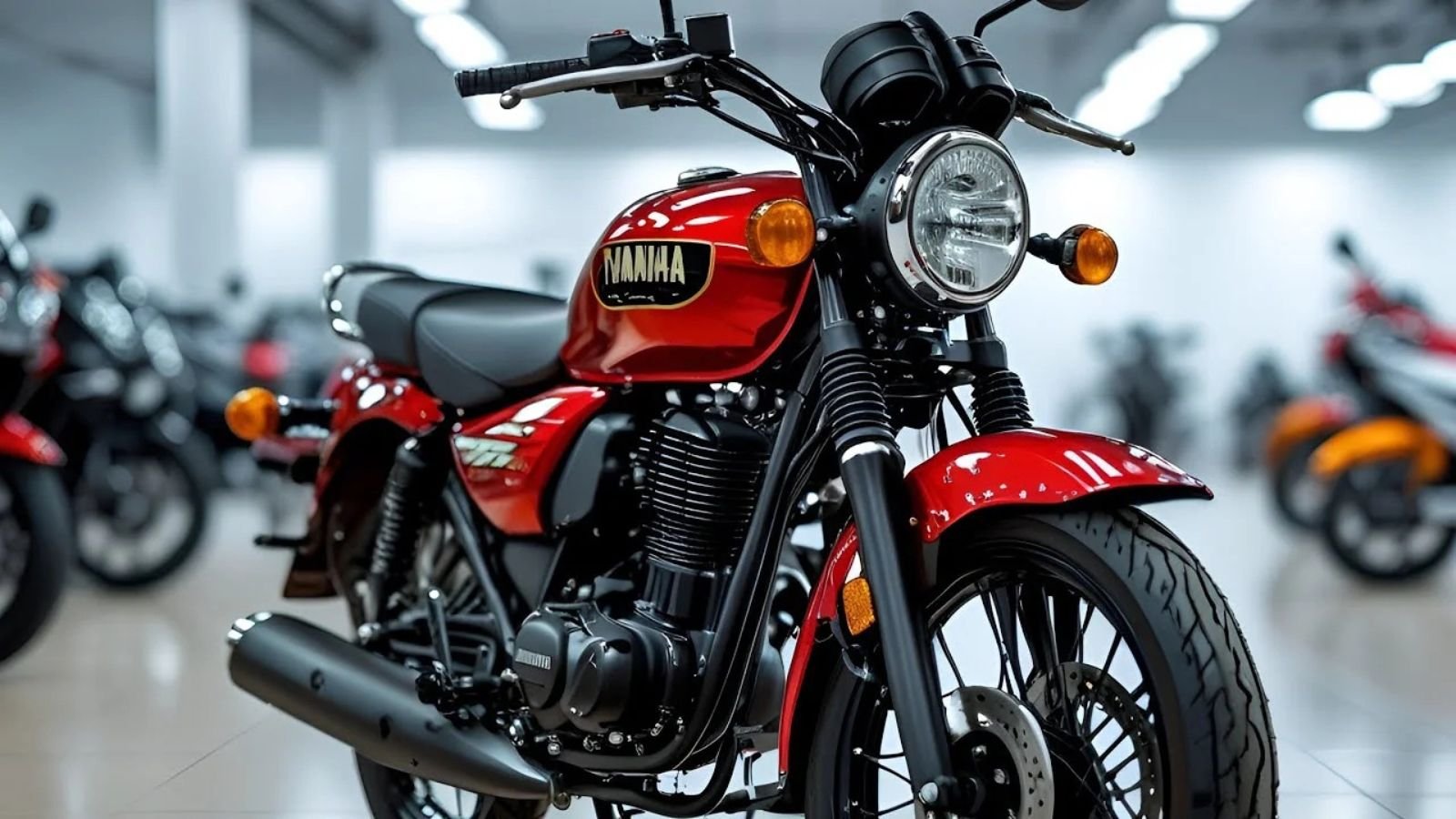The Yamaha RX100 isn’t just a motorcycle—it’s a cultural icon, a legacy, and a symbol of pure two-stroke adrenaline. For countless Indian riders who came of age in the late 1980s and early 1990s, the RX100 wasn’t just transportation—it was a badge of honor, a machine that turned heads, and an unforgettable part of their youth. Today, decades after it vanished from showrooms, the Yamaha RX100 continues to spark enthusiasm and nostalgia, earning its spot in the hall of fame of Indian motorcycling.
Let’s take a deep, heartfelt journey into what made this bike legendary and why the Yamaha RX100 remains a dream machine for riders even in 2025.
Yamaha RX100 – Key Highlights
| Feature | Details |
|---|---|
| Engine | 98cc, air-cooled, 2-stroke engine |
| Power | Approx. 11 HP |
| Gearbox | 4-speed manual transmission |
| Weight | Around 100 kg |
| Top Speed | Approx. 100 km/h |
| Brakes | Drum brakes at both front and rear |
| Fuel Efficiency | 25-30 km/l (depending on condition) |
| Suspension | Telescopic forks (front), swingarm (rear) |
| Production Years | 1985 to 1996 |
| Legacy | Cult icon, unmatched in nostalgia |
What Made the Yamaha RX100 a Game-Changer?
When Yamaha RX100 debuted in India in 1985, it created an instant sensation. Until then, Indian roads were dominated by slow, practical commuters. Riders had very few choices if they wanted something fast, fun, and loud. The RX100 arrived like a firecracker—its compact frame, aggressive acceleration, and signature two-stroke exhaust note rewrote the rules of performance biking in India.
This bike wasn’t designed to just get you from point A to point B—it was engineered to make that ride thrilling. The 98cc, air-cooled, two-stroke engine might seem small by today’s standards, but it packed a serious punch. With an output of roughly 11 HP and a weight of just around 100 kg, the Yamaha RX100 had one of the best power-to-weight ratios in its category at the time. The result? Mind-blowing throttle response, instant acceleration, and a machine that felt alive beneath you.
Even today, ask any veteran biker what set the RX100 apart, and you’ll likely hear one word: “Feel.”
Design That Aged Like Fine Wine
One of the reasons why the Yamaha RX100 continues to be celebrated even decades later is its timeless design. With its teardrop-shaped fuel tank, upright handlebars, sleek flat seat, and chrome-finished elements, the RX100 was a mix of simplicity and sporty elegance.
Unlike many bikes of that era that looked dull or bulky, the RX100 had an athletic posture. Its round headlight, twin pod instrument cluster, and chrome mudguards made it visually distinct. The proportions were spot on—not too big, not too small—and everything on the bike had a purpose. The Yamaha RX100 looked just as good parked outside a college campus as it did racing down a rural road.
Even today, restored RX100s are crowd-pullers. With the right paint job and chrome polish, they shine like jewels, making them a favorite among bike collectors and vintage enthusiasts.
Features That Stood the Test of Time
Though the Yamaha RX100 might appear basic compared to today’s modern motorcycles with touchscreen displays and smartphone connectivity, back in the 80s and 90s, it was ahead of its time in several ways.
Here’s what made it special:
- Engine & Gearbox: The 98cc, two-stroke engine was simple but brilliantly engineered. It was easy to maintain, tunable, and delivered performance beyond expectations. The 4-speed manual gearbox was smooth and responsive, making riding effortless whether you were in city traffic or on open roads.
- Suspension: With telescopic front forks and a swingarm-type rear setup, the RX100 offered a surprisingly comfortable ride, even on bumpy Indian roads.
- Brakes: Both wheels had drum brakes, which were the norm at the time. Though not as effective as modern discs, they were adequate given the bike’s weight and top speed.
- Fuel Efficiency: For a two-stroke engine, the RX100 managed a decent mileage of around 25-30 km/l, depending on riding style and tuning. That might not impress today’s mileage-focused commuters, but back then, it was more than acceptable given the thrill the bike delivered.
The Yamaha RX100 in Racing and Modification Culture
Beyond the streets, the Yamaha RX100 carved a niche for itself in India’s underground racing culture. The bike’s high-revving nature, light frame, and easily modifiable engine made it a staple in local drag races and hill climbs. Riders tweaked the carburetors, fitted expansion chambers, and swapped out pistons to extract even more performance.
In many cities, it became common to see custom RX100s with unique liveries, louder exhausts, and even twin silencers. Garage builders loved working on the RX100 because of its straightforward mechanics and endless potential for personalization. Even today, a modified Yamaha RX100 can command as much attention as a new-age superbike.
The Emotional Connect of a Generation
What truly set the Yamaha RX100 apart was the emotional bond it created with its riders. It wasn’t just a bike—it was a rite of passage. For many, it was their first taste of speed, freedom, and independence. College students, young office-goers, and aspiring racers all found common ground in their love for this machine.
Ask any RX100 owner, and they’ll tell you how the bike “spoke” to them—the sound of the exhaust, the way it pulled in third gear, the unmistakable aroma of two-stroke oil in the morning. These aren’t technical specifications—they’re experiences. And no other motorcycle captured hearts quite like the Yamaha RX100.
Why Was the Yamaha RX100 Discontinued?
Despite its cult following, the Yamaha RX100 couldn’t survive India’s changing environmental regulations. As the country moved towards stricter emission norms in the late 1990s, two-stroke engines like that of the RX100 were no longer viable.
Yamaha had to discontinue the RX100 in 1996. It was replaced by models like the RX135 and RXZ, which tried to carry the torch forward. While those models had their own fan base, they never quite matched the raw charm of the original RX100.
Today, many enthusiasts dream of a modern revival of the RX100 in a four-stroke, BS6-compliant avatar. While Yamaha has hinted at its interest in reviving the nameplate, as of 2025, nothing official has been launched. Still, the dream lives on.
Frequently Asked Questions (FAQs)
Q. Is the Yamaha RX100 still available in new condition?
No. The Yamaha RX100 was discontinued in 1996. However, enthusiasts can still find used or restored models through classified ads, bike collectors, and restoration garages.
Q. What is the current market value of the Yamaha RX100?
Prices vary widely. A used RX100 in poor condition may cost around ₹50,000, but fully restored or modified versions can fetch up to ₹1.5 lakh or more, depending on customization and originality.
Q. Is the RX100 good for daily use in 2025?
It can be, but only for enthusiasts. Since it’s an old two-stroke motorcycle, it needs regular maintenance. Spare parts are getting rare, and fuel efficiency is lower compared to modern four-stroke bikes.
Q. Can you still find RX100 spare parts?
Yes, but with effort. Some vintage bike specialists stock refurbished or compatible parts. There are also online communities and forums that help with sourcing components.
Q. Why is the Yamaha RX100 considered fast for its time?
Its lightweight frame combined with a high-revving two-stroke engine made the Yamaha RX100 incredibly quick off the line. It could easily outpace heavier, four-stroke rivals of that era.
Conclusion
The Yamaha RX100 is not just a motorcycle; it’s a symbol of a golden era in Indian motorcycling. Its legacy is built not only on performance and design but on the memories it gave its riders. Whether it was the roar of the exhaust, the thrill of acceleration, or the joy of Sunday rides with friends, the RX100 delivered it all.
Even decades after being discontinued, the Yamaha RX100 remains relevant—a true testament to its timeless appeal. For those lucky enough to ride one today, it’s not just about owning a bike; it’s about keeping a legend alive. Whether Yamaha chooses to revive it or not, the RX100 will forever be remembered as one of the most iconic machines to ever grace Indian roads.
Have you ever ridden the Yamaha RX100 or dreamt of owning one? Share your story—because legends like these deserve to be celebrated.
Some Important Link
| Telegram Group | Click Here |
| WhatsApp Group | Click Here |
| Home Page | Click Here |















